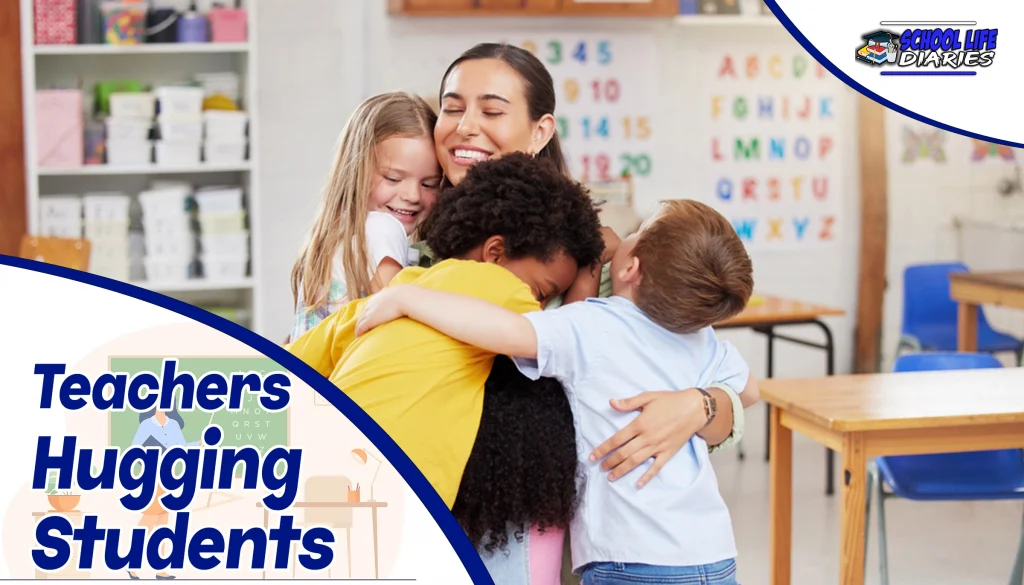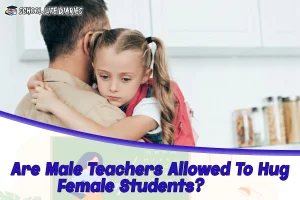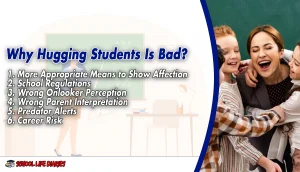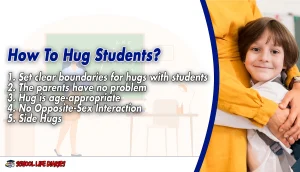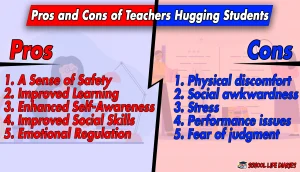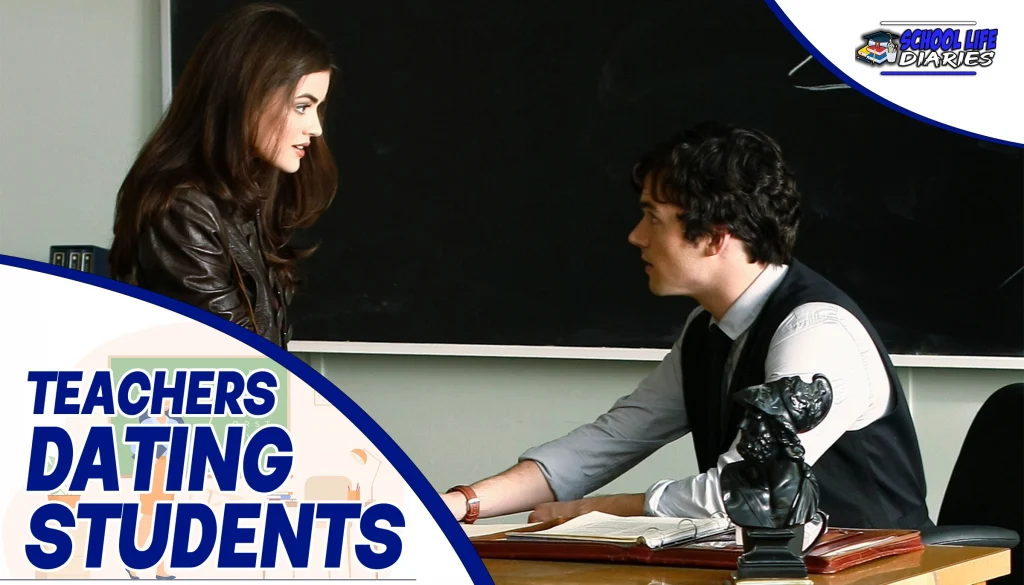The practice of teachers hugging students has become increasingly accepted in recent years. While in the past, it may have been seen as overly familiar or even inappropriate behavior, today more and more schools are embracing this expression of warmth and affection among educators and learners.
Research backs up the idea that teacher-student hugs can increase feelings of connection, trust, and emotional support. Studies have found that when students are hugged by teachers, they show higher levels of self-esteem, better academic performance, and decreased instances of behavioral problems.
Teacher-student hugs can help foster an environment where both the educator and the learner feel safe and supported. Teacher-student hugs can be a powerful tool that schools can use to promote emotional well-being among their students.
Are Teachers Allowed To Hug Students?
Yes, in certain circumstances teachers may be allowed to hug students, but it should be done with sensitivity and respect for the student’s comfort levels. The decision will depend on what is most appropriate and respectful in each individual situation. Most schools discourage physical contact between teachers and students as it is not professional conduct.
In some cases, such as offering comfort or reassurance to a student who is grieving or struggling with an emotional issue, a teacher may decide to offer a hug. It is important for teachers to be aware of the potential implications of physical contacts, such as making students feel uncomfortable or creating an atmosphere that could lead to allegations of inappropriate behavior.
Can A Teacher Hug Their Students?
Yes, teachers can hug their students if it is done in an appropriate and respectful manner. While some people believe that physical affection between students and teachers can create a closer bond and make students feel more comfortable, others worry that such gestures could be seen as inappropriate.
When it comes to teachers hugging students, it’s important to consider the age and maturity level of the students in question. It’s also important to be aware of school policies and guidelines on physical contact with students. It’s important for teachers to show respect for their students’ feelings and boundaries.
Can You Ask My Teacher For A Hug?
Yes, it is possible to ask your teacher for a hug, but it would be best to make sure that parents or school authorities are present first. This is because even a seemingly innocent hug could be misinterpreted by someone and have serious consequences for the teacher, potentially ruining their career.
A side hug can be an appropriate way to show affection and appreciation for your teacher in the presence of parents or school authorities. This can be a way to show your teacher that you care while also protecting their professional standing.
Are Male Teachers Allowed To Hug Female Students?
No, male teachers are not allowed to hug female students. This is due to the fact that physical contact between a male teacher and a female student can be misunderstood, misinterpreted, or lead to accusations of improper conduct. It is a violation of the professional code of conduct for teachers and would be considered an act of inappropriate physical contact.
Not only does it undermine the teacher-student relationship, but it could also create a hostile environment for the student, as well as other students who witness this behavior. To protect themselves and their professional reputation, many schools have policies in place explicitly prohibiting teachers from touching students.
Are Teachers Allowed to Make Physical Contact With Students?
No, the majority of school districts have policies that prohibit physical contact between teachers and students, except in certain cases such as providing comfort or assistance to a student who is injured or ill. Most teachers will not touch a student for any other reason. Teachers must be mindful of the laws and regulations that are in place to protect students’ rights.
Physical contact between a teacher and a student is considered inappropriate and may even lead to disciplinary action or legal action against the teacher. It is important for teachers to understand their district’s policy on physical contact as well as state and federal laws so they can be aware of their own boundaries.
Is It Illegal For Teachers to Hang Out With Students?
No, it is not illegal for teachers to hang out with students. While there is no law against such an action, it is important that the interaction between teachers and students be kept strictly professional at all times.
If a teacher wishes to interact with their student outside of school, they should always invite other students in the class or grade level along to ensure a group setting, which can help to avoid potentially inappropriate situations.
It is also important for students to inform their parents of the teachers, friends, and peers they are spending time with the outside of school. Parents should take an active role in their child’s safety and well-being by providing transportation or accompaniment when needed.
Can You be Friends With Your Teacher?
Yes, it is possible to have a friendly relationship with your teacher. This can be beneficial for both the student and the teacher by improving the learning experience in the classroom. Having a respectful and fun interaction between students and teachers helps to create an environment of trust, collaboration, and mutual understanding.
A positive classroom atmosphere has been shown to create better student engagement, which helps to improve learning outcomes. Students who feel comfortable and respected in their classroom environment are more likely to ask questions and interact with their teachers. This allows them to gain a better understanding of the topics being taught, as well as develop beneficial relationships between students and teachers.
Can You Argue With Teachers For Hugging?
No, it is not appropriate to argue with teachers over hugging. Physical contact between teachers and students is a sensitive subject as it can be interpreted as a violation of trust or boundaries. There may be legal restrictions in certain areas that prevent teachers from engaging in physical contact with their students.
The power dynamic between a teacher and student means that the teacher must exercise caution when showing physical affection to a pupil. A teacher should never use physical contact as a way to reward or punish students. Instead, verbal and nonverbal communication should be used in order to motivate students or express disappointment with their behavior.
Why Hugging Students Is Bad?
Hugging students can be considered bad for a variety of reasons, particularly in terms of boundaries and safety. Physical contact between teachers and students can blur the line between personal and professional relationships, creating an environment that is not conducive to learning. Let’s take a look at a few of the reasons hugging students can be considered bad:
1. More Appropriate Means to Show Affection:
Hugs might seem like an appropriate way for teachers to show affection to their students, but in reality, there are more appropriate means of expressing care and concern that don’t involve physical contact. This can include gestures such as a hand on the shoulder or knuckles to a high five. These gestures don’t have the potential to be misinterpreted and create an uncomfortable situation.
2. School Regulations:
Most schools have policies that require teachers to maintain a professional relationship with their students, and physical contact between teacher and student is often discouraged or prohibited in order to protect both. As such, when it comes to showing affection, teachers should be mindful of the regulations and act accordingly.
3. Wrong Onlooker Perception:
Even if both the teacher and student are comfortable with hugs, other bystanders may not be. This can lead to misperceptions about the relationship between teacher and student which in some cases, could lead to legal action or an ugly situation. More importantly, it could send the wrong message to other students in the school and create an atmosphere of mistrust.
4. Wrong Parent Interpretation:
It is important to be aware that a hug from a teacher to a student can be interpreted differently by the student’s parents. Even if the intent of the hug was friendly and platonic, it can still be perceived as inappropriate for a teacher to have physical contact with a student. It is important for teachers to be aware of how their actions can be interpreted, and to take the necessary steps to avoid any potential misunderstandings.
5. Predator Alerts:
A hug from a teacher is not only potentially misconstrued; it could also put the teacher at risk of being mistaken as a predator by other students or parents. If a teacher is seen to be engaging in physical contact with one student, it could raise suspicions and lead to false accusations. It is important for teachers to understand that even if their intentions are innocent, they should never engage in any physical contact with students as it carries too much risk.
6. Career Risk:
Even if a hug was misinterpreted or if a teacher was falsely accused of inappropriate behavior, the damage to their career could be irreparable. Teachers are expected to maintain professional boundaries at all times, and physical contact with students is not tolerated in any case. It is important for teachers to understand the risks associated with physical contact, and how it could adversely affect their careers.
Can a Teacher be Fired For Hugging a Student?
Yes, a teacher can be fired for hugging a student if the hug is inappropriate or unwarranted. Depending on the context of the hug and the student’s age, it could be seen as an abuse of power or a breach of trust.
Depending on various factors such as school board policies and state laws, teachers may have to face serious consequences for their actions. It is important that teachers maintain a professional relationship with all students, and avoid physical contact or hugs in order to remain within the bounds of appropriate behavior.
How To Hug Students?
Hugging students in the classroom can be a positive way to express care and affection while also teaching important social skills and creating a sense of community amongst peers. Here are some ways how to hug students:
1. Set clear boundaries for hugs with students:
The teacher should ensure that the student understands that there is a professional relationship between them, and that physical contact should reflect this. It is important to explain to the student why the hug is taking place in order to reduce any possible confusion or misunderstanding. The teacher should also be aware that the hug may not be welcomed by some students.
2. The parents have no problem:
Make sure to get permission from the parents or guardians of the student prior to offering a hug. This prevents any complications with school policy and ensures that both the teacher and parent are on board with such contact. It is important to make sure that the reasoning behind why it is appropriate to share a hug is fully understood by the parent.
3. Hug is age-appropriate:
Make sure that the hug is age-appropriate, and that it is not too long or uncomfortable for the student. A tight hug from an adult may feel strange or intimidating to some students, so it’s best to keep physical contact brief and light. It is also a good idea for teachers to keep track of the amount and type of hugs they give out.
4. No Opposite-Sex Interaction:
When hugging students, it is important to maintain a certain level of respect and professionalism. No physical contact between opposite sexes should be allowed under any circumstances; even friendly hugs can cause confusion or awkwardness in some students. Side hugs are a good way to show affection without crossing this boundary.
5. Side Hugs:
No hug should be too long or hard, as this can feel intimidating to some students. A good side hug should last no more than a few seconds and involve minimal body contact; keep your arms at your sides if possible. This will show respect for the student while still conveying warmth and care.
Related Article: Teachers dating students and why it is bad and how to prevent it?
Pros and Cons of Teachers Hugging Students
Teachers hugging students is a practice that has become more common in recent years, and with good reason. There are some pros and cons for both the student and the teacher when it comes to this practice.
Pros of Teachers Hugging Students
1. A Sense of Safety:
A physical touch from an adult can help provide a sense of safety for a student who might be feeling scared or overwhelmed.
2. Improved Learning:
Studies have shown that students who receive physical contact from teachers tend to perform better in the classroom compared to those that do not. This may be due to the fact that hugging creates an environment of trust and acceptance, which can help foster learning.
3. Enhanced Self-Awareness:
Students who receive hugs from their teachers may be more in tune with their emotions, leading to better self-regulation and the ability to cope with stress.
4. Improved Social Skills:
Hugs can provide a sense of belonging, which is important for developing social skills. A hug from a teacher can help students feel connected to their peers and build relationships.
5. Emotional Regulation:
Hugs can provide relief from stress and anxiety, helping students to regulate their emotions in a healthy way.
Cons of Teachers Hugging Students
1. Physical discomfort:
Many students may not feel comfortable with physical contact or displays of affection, especially if such physical contact is unexpected or unanticipated. This discomfort could be caused by anxiety, fear, or various other emotional factors. This could lead to the student feeling uncomfortable and even embarrassed in the presence of their peers and teachers alike.
2. Social awkwardness:
Even if physical contact is not an issue, some students may feel socially uncomfortable in certain situations where they are expected to interact with their peers or teachers. This could be due to a lack of experience in socializing with others, shyness, or even having a limited understanding of the appropriate behaviors and expectations that come with particular social situations.
3. Stress:
Even if the student is not actually participating in a physical or social situation, the anticipation and expectation of having to do so can be enough to cause stress for some students. This could lead them to become overwhelmed and unable to cope with the pressure of having to perform in front of others, leading to feelings of anxiety and fear.
4. Performance issues:
Performance can be impacted if the student is not able to emotionally connect with the material that they are being asked to present or perform. This could lead to them feeling disconnected from their work, making it difficult for them to express themselves in a meaningful way.
5. Fear of judgment:
Fear of judgment can also cause issues for some students, especially if they feel like their peers or teachers expect them to do well in whatever task is being asked of them. This fear could lead to the student feeling overwhelmed and unable to perform up to their best standards.
Write Privacy Policies of Teachers Hugging Students
1. Teachers must obtain written consent from a student’s parent or guardian prior to initiating physical contact such as hugging the student. The requested permission should be documented in writing for future reference.
2. The teacher is only allowed to hug a student if the parent or guardian has consented and the teacher’s behavior is appropriate, respectful, and non-threatening.
3. It is important to avoid inappropriate physical contact with students, including but not limited to: backrubs, tickling, touching of any kind on the student’s body or clothing, and holding a student in an embraced position for an extended period of time.
4. The teacher should always maintain a professional distance with their students, maintaining at least an arm’s length between themselves and the student when physical contact is occurring.
5. Whenever possible, teachers should attempt to have another adult present as a witness when physical contact with a student is necessary.
6. When hugging is necessary and appropriate, it should be a brief hug that is not overly intimate or affectionate.
7. The teacher must ensure the student’s comfort level before initiating any physical contact and must respect their wishes if they are uncomfortable with being hugged.
Final Verdict: Teachers Hugging Students
Teachers play an important role in the lives of their students. A teacher’s hug can be a powerful symbol of all that they hope for their students. It can communicate warmth, caring, and acceptance. For some teachers hugging their students may come naturally and feel like the most natural way to express care and concern.
Though often overlooked, the benefits of a teacher hugging their students are clear. When done with intention and in the right context, teachers can use this simple act to build trust and relationships with their students, improve student behavior, and create a more positive classroom environment overall.

